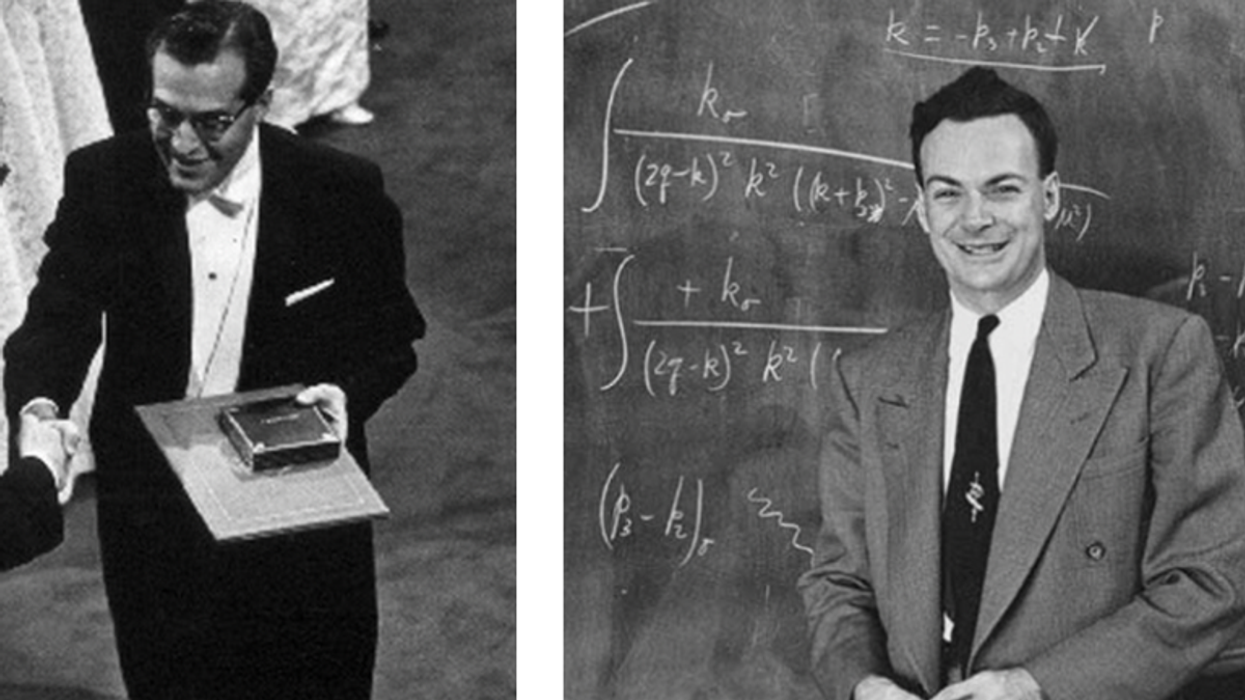They made jewelry from plane parts, and bridesmaid dresses from parachute silk. In Britain, men and women found new ways to dress with creative approaches to the traditional military and civilian uniforms of WWII, the results of which are now on display at the Imperial War Museum London until August 31. Fashion on the Ration features 300 upcycled items, including our favorite, a gas mask handbag, and helps mark the 70th anniversary of the end of the Second World War.
In 1941, textiles for making clothing were scarce and highly coveted. The “Make Do and Mend” campaign launched by the government literally pushed the public to make do with what they had; fixing items so they lasted longer. As barely anyone could buy new, making and mending became the norm, with garment rationing sparking an incidental movement of DIY fashion. Clever, ingenious approaches emerged—for example, lingerie sewn from silk-made aviation maps. Pattern classes and sewing at home became more popular. Everyone got more creative, building their own individual style. Some might even say this war campaign inspired an initial, specific wave of crafting and upcycling that has now seen a popular resurgence with today’s youth. But when we see repurposed clothing on Pinterest and Etsy, are we really viewing a movement with humble roots in the 1940s?
“I think the concept of longevity is back with us in fashion, something we haven’t seen since the Second World War,” said British fashion historian Amber Butchart. “We’re beginning to realize the fast fashion system is unsustainable—economically, ecologically, and ethically.”
Even during the war, women went to great lengths for personal appearance. Since almost everyone was wearing army uniforms, a great deal of pressure was put on clothing manufacturing companies, and shortages were rampant. It was a time when boot polish was used as crude mascara and lipstick was given military names like “Regimental Red.”
Cosmetics were rare, but still available, though metal cases for compacts were not; one compact was even placed inside a mock military hat. It was “a last desperately defended luxury,” Vogue said in 1942, as beetroot became a popular alternative for lip color. Cosmetics were saddled with a luxury tax, which made them expensive. But women couldn’t let go of their looks entirely, and it was a commonly held belief that to let their standards slip would be bad for wartime morale.
Fashion on the Ration is divided into six sections that explore how fashion managed to thrive during the war. One section examines uniforms and how they helped transform style, prompting pride for insiders and envy for outsiders, while the functional fashion section shows siren suits, which were worn in air-raid shelters. London was also plagued by blackouts, which by 1939 were frequent. So German bombers wouldn't find their targets in the United Kingdom, there were no street lights in public spaces. It was completely dark at night. There were plenty of accidents, so a safety campaign was launched so people could be seen. Glow-in-the-dark, luminescent brooches were created. People were also encouraged to wear white so cars could spot them. A section devoted to utility clothing shows the ‘Austerity Regulations,’ which mandated a maximum height of two inches for high heels. The exhibition also takes a look at inventive reuse with examples like a children's cloak crafted from a blanket. In short, it was upcycling before it was all the (voluntary) rage.
“Initiatives like Make Do and Mend are again on the rise, as we’re living through another age of austerity imposed on us by the government’s post-2008 crash,” said Butchart.
Some of the original Make and Do Mend tips included learning how to sew, turning old textiles into something new (curtains into dresses), and encouraging clothing swaps and knitting.
Another theme explored in the show is patriotic fashion, like the Jacqmar of London scarves made from 1940-45 boasting war slogans like “Switch That Light Off” (an energy-saving reminder we should still all use today). The “Salvage Your Rubber” scarf was made for the export market, as chief designer of Laqmar scarves, Arnold Lever divided the scarves into three categories: the armed forces, allies, and home front, each emblazoned with the Jacqmar name.
Rationing ended in 1949, but the DIY nature of the era has direct results in contemporary fashion. The scaled-back times pushed development for the first crop of mass-market lines from high-end designers, which was the first time fashion strayed away from formality. In other words, if it wasn't for the Second World War, we wouldn't be wearing designer jogging pants and hoodies. There was also a growing need for inexpensive, informal, protective clothing. It was a time when people didn’t have to wear strict military outfits, adorned with badges. Department stores began selling a variety of stuff (yes, an actual variety), including casual wear. The war introduced “military chic” to the general population as fashion. “With regards to style, military tailoring impacted fashion in a big way during the war,” said Butchart, whose forthcoming book on maritime fashion Nautical Chic came out March 30. “The military effect is something we still regularly see in fashion; naval and regimental styles are perennial trends.”
Fashion on the Ration: 1940s Street Style is on view at the Imperial War Museum London until August 31, 2015.
















 Otis knew before they did.
Otis knew before they did.